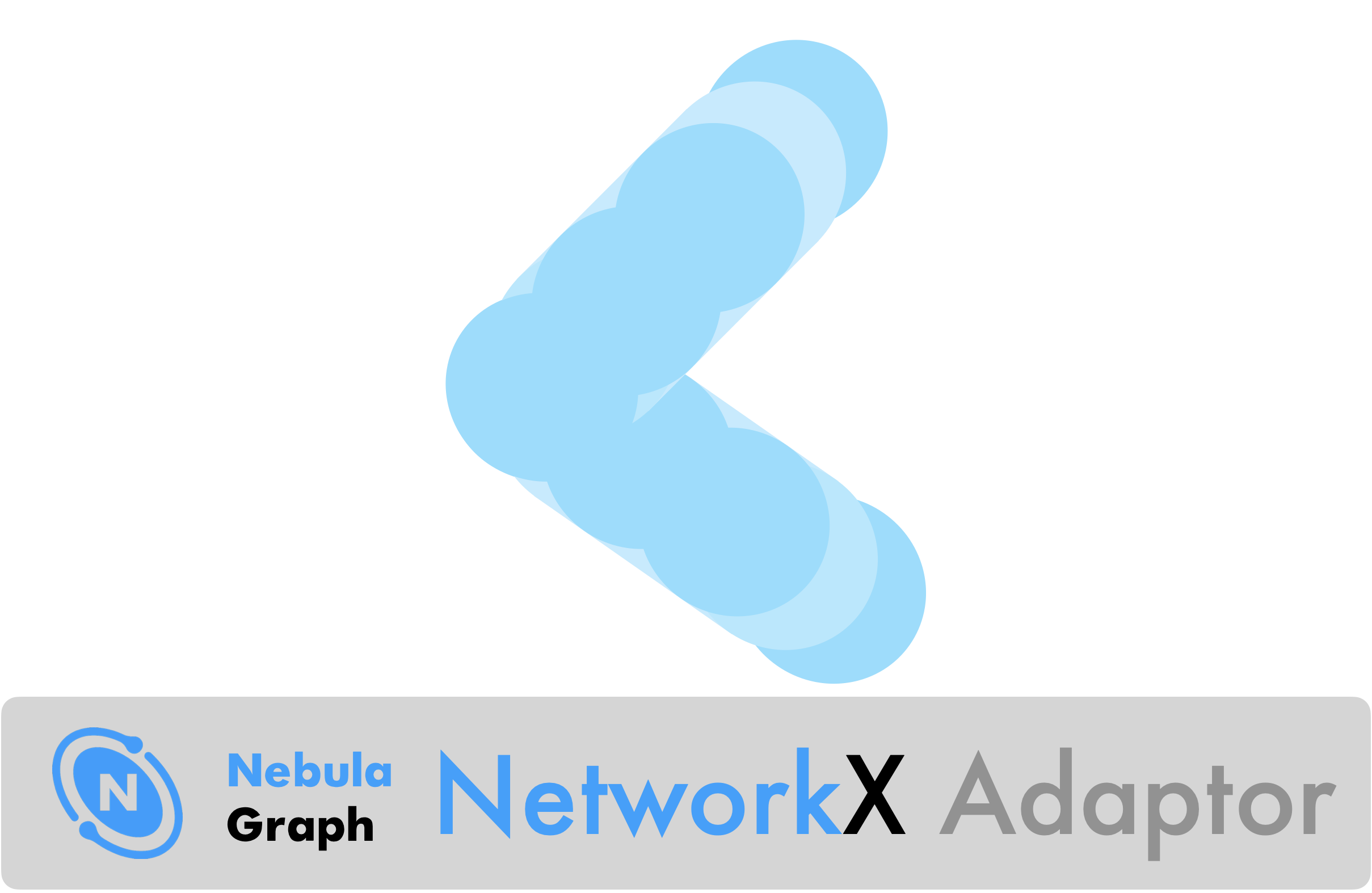NebulaGraph NetowrkX Adaptor
Project description

Manipulate and analyze NebulaGraph data using the NetworkX API
Documentation: https://github.com/wey-gu/nebulagraph-nx#documentation
Source Code: https://github.com/wey-gu/nebulagraph-nx
Table of Contents
Introduction
NebulaGraph NetworkX (ng_nx) is a powerful tool that bridges NebulaGraph and NetworkX, enabling you to leverage NetworkX's rich set of graph algorithms and analysis tools on data stored in NebulaGraph. This integration combines NebulaGraph's advanced storage capabilities with NetworkX's extensive graph analysis functionality.
Features
- Seamless integration between NebulaGraph and NetworkX
- Multiple reader types for flexible data retrieval
- Easy-to-use writers for storing analysis results back to NebulaGraph
- Support for both vertex and edge data operations
- Compatibility with NetworkX's extensive library of graph algorithms
Installation
Ensure you have a NebulaGraph cluster running. For a quick setup, you can use NebulaGraph Lite to set up a cluster in Colab within 5 minutes.
Install ng_nx using pip:
pip install ng_nx
Usage
Reading Data from NebulaGraph
from ng_nx import NebulaReader
from ng_nx.utils import NebulaGraphConfig
config = NebulaGraphConfig(
space="basketballplayer",
graphd_hosts="127.0.0.1:9669",
metad_hosts="127.0.0.1:9559"
)
reader = NebulaReader(
edges=["follow", "serve"],
properties=[["degree"], ["start_year", "end_year"]],
nebula_config=config, limit=10000)
g = reader.read()
Running Algorithms
import networkx as nx
import community as community_louvain
# Run PageRank algorithm
pr = nx.pagerank(
g, alpha=0.85,
max_iter=100,
tol=1e-06,
weight='degree')
# Run Louvain community detection
ug = g.to_undirected()
louvain = community_louvain.best_partition(ug)
Writing Results Back to NebulaGraph
Typical use cases are:
- Write the result of graph algorithm to NebulaGraph as vertex data.
- Write the result of graph algorithm to NebulaGraph as edge data.
Write Vertex Data to NebulaGraph after Graph Analysis
We could create schema for pagerank and louvain like this:
CREATE TAG IF NOT EXISTS pagerank (
pagerank double NOT NULL
);
CREATE TAG IF NOT EXISTS louvain (
cluster_id int NOT NULL
);
Then we can run pagerank and louvain algorithm and write the result to NebulaGraph like this:
from ng_nx import NebulaWriter
pr_writer = NebulaWriter(data=pr, nebula_config=config)
# properties to write
properties = ["pagerank"]
pr_writer.set_options(
label="pagerank",
properties=properties,
batch_size=256,
write_mode="insert",
sink="nebulagraph_vertex",
)
# write back to NebulaGraph
pr_writer.write()
# write louvain result
louvain_writer = NebulaWriter(data=louvain, nebula_config=config)
# properties to write
properties = ["cluster_id"]
louvain_writer.set_options(
label="louvain",
properties=properties,
batch_size=256,
write_mode="insert",
sink="nebulagraph_vertex",
)
louvain_writer.write() # write back to NebulaGraph
Write Edge Data to NebulaGraph after Graph Analysis
Say we have a graph with player and follow edge, we can write the result to NebulaGraph like this:
CREATE TAG IF NOT EXISTS player (
name string NOT NULL,
age int NOT NULL
);
CREATE EDGE IF NOT EXISTS follow (
start_year int NOT NULL,
end_year int NOT NULL
);
We can write the result to NebulaGraph like this:
from ng_nx import NebulaWriter
# Example edge data
edge_data = [
("player1", "player2", 0, [2022, 2023]), # src, dst, rank, [start_year, end_year]
("player2", "player3", 1, [2021, 2022]),
# ... more edges ...
]
edge_writer = NebulaWriter(data=edge_data, nebula_config=config)
# properties to write, map the properties to the edge data
properties = ["start_year", "end_year"]
edge_writer.set_options(
label="follow", # Edge type name
properties=properties,
batch_size=256,
write_mode="insert",
sink="nebulagraph_edge",
)
# Write edges to NebulaGraph
edge_writer.write()
Using NebulaQueryReader
The NebulaQueryReader allows you to execute any NebulaGraph query and construct a NetworkX graph from the result.
from ng_nx import NebulaQueryReader
from ng_nx.utils import NebulaGraphConfig
config = NebulaGraphConfig(
space="demo_basketballplayer",
graphd_hosts="127.0.0.1:9669",
metad_hosts="127.0.0.1:9559"
)
reader = NebulaQueryReader(nebula_config=config)
# Execute a custom query
query = "MATCH p=(v:player{name:'Tim Duncan'})-[e:follow*1..3]->(v2) RETURN p"
g = reader.read(query)
This approach allows you to leverage the full power of NebulaGraph's query language while still being able to analyze the results using NetworkX.
Advanced Usage
NebulaQueryReader
The NebulaQueryReader allows you to execute any NebulaGraph query and construct a NetworkX graph from the result.
from ng_nx import NebulaQueryReader
from ng_nx.utils import NebulaGraphConfig
config = NebulaGraphConfig(
space="demo_basketballplayer",
graphd_hosts="127.0.0.1:9669",
metad_hosts="127.0.0.1:9559"
)
reader = NebulaQueryReader(nebula_config=config)
# Execute a custom query
query = "MATCH p=(v:player{name:'Tim Duncan'})-[e:follow*1..3]->(v2) RETURN p"
g = reader.read(query)
Readers
NG-NX provides three types of readers to fetch data from NebulaGraph:
-
NebulaReader: Reads a graph from NebulaGraph based on specified edges and properties, returning a NetworkX graph. It uses the MATCH clause internally to fetch data from NebulaGraph. -
NebulaQueryReader: Executes a custom NebulaGraph query and constructs a NetworkX graph from the result. This reader is particularly useful when you need to perform complex queries or have specific data retrieval requirements. -
NebulaScanReader(Coming soon): Will read graph data from NebulaGraph using a configuration similar toNebulaReader, but it will bypass the MATCH clause and utilize the SCAN interface with the Storage Client for potentially improved performance on large datasets.
Each reader is designed to cater to different use cases, providing flexibility in how you interact with and retrieve data from NebulaGraph for analysis with NetworkX.
Documentation
Contributing
Contributions are welcome! If you find any issues or have suggestions for improvements, please open an issue or submit a pull request on the GitHub repository.
Project details
Release history Release notifications | RSS feed
Download files
Download the file for your platform. If you're not sure which to choose, learn more about installing packages.
Source Distribution
Built Distribution
File details
Details for the file ng-nx-0.2.0.tar.gz.
File metadata
- Download URL: ng-nx-0.2.0.tar.gz
- Upload date:
- Size: 15.2 kB
- Tags: Source
- Uploaded using Trusted Publishing? No
- Uploaded via: pdm/2.18.1 CPython/3.11.9 Darwin/23.6.0
File hashes
| Algorithm | Hash digest | |
|---|---|---|
| SHA256 | e617a0eac67b80cf59c5f445bd65e5da5e53fe849fd0d4afa3a7b9c286b10d69 |
|
| MD5 | 5695842b374f48f4000dfc95aadd7977 |
|
| BLAKE2b-256 | f722b2d3c62109eb22e8bcdb2eef1caee71a056279edd12afe0ae9674d660f72 |
File details
Details for the file ng_nx-0.2.0-py3-none-any.whl.
File metadata
- Download URL: ng_nx-0.2.0-py3-none-any.whl
- Upload date:
- Size: 13.5 kB
- Tags: Python 3
- Uploaded using Trusted Publishing? No
- Uploaded via: pdm/2.18.1 CPython/3.11.9 Darwin/23.6.0
File hashes
| Algorithm | Hash digest | |
|---|---|---|
| SHA256 | ac686a94663654e16e3dcc8c8c54c3d3207d67e809bca737127fd535427eebd1 |
|
| MD5 | b85d5671dfbdbdf90b7eabaed05c1fdc |
|
| BLAKE2b-256 | 3b9375ee0d07257d4616bdc80d4b87db26e713f5b49e8a1fecf19b3c850dee2f |















